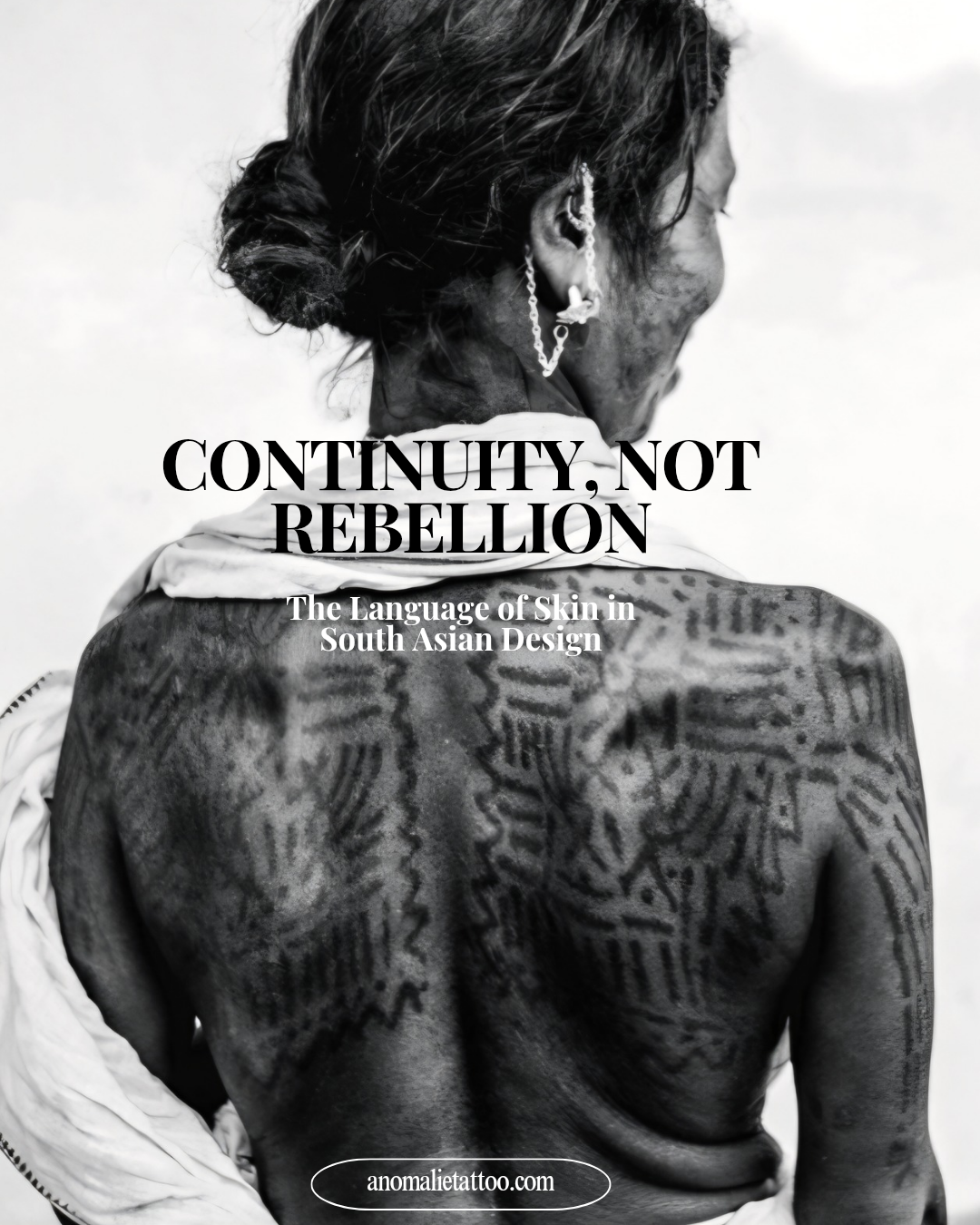South Asia has always known the language of skin. We’re only just remembering it.
In South Asia, design has never been a separate category—it lives in how we decorate the ordinary. The way fabric folds, the symmetry of a temple arch, the repetition of a motif on a sari border. Ornamentation isn’t excess here; it’s rhythm. So when we speak of tattoos—whether permanent or temporary—we’re returning to something the region has always understood: that the body itself is a canvas of belonging.

The history of skin adornment in our part of the world is older than ink. From mehndi to alta, from tribal markings in Odisha to the luminous body painting of Kerala’s Theyyam dancers, every region has inscribed identity onto the body. Tattoos, in this context, aren’t rebellion. They’re continuity.

Eg: Theyyam dancer from Kerala
Tracing Lines Backwards
When Anomalie began, I kept thinking about the word anomaly—something that doesn’t fit. But in truth, much of what we now call “modern tattooing” fits perfectly within older South Asian rhythms. Women in Rajasthan marking their arms with geometric dots. Fisherfolk in coastal villages wearing family emblems for protection. Nomadic communities carrying their lineage in symbols rather than surnames.

Eg: Rajasthani Tattoo Style
What we’ve done, perhaps, is forgotten how to read those marks. Clean design, as the Western world defines it, often means minimal and unadorned. But here, minimalism has always meant intention—knowing what to keep and what to repeat. Our art is dense, but it’s never cluttered. Every stroke knows its place.
The South Asian Eye
The South Asian eye is trained to see pattern in chaos. To us, balance is not symmetry but dialogue—between line and curve, matte and shine, body and shadow. A brass bangle next to a cotton kurta. A mandala made of rice flour (kolam/ rangoli) that vanishes by evening. This aesthetic sense naturally lends itself to tattooing. We understand the beauty of the impermanent, the hand-drawn, the irregular.

Eg: Kolam/ Rangoli
It’s why Floral motifs thrive in our visual culture—they mimic embroidery, mehndi, and the cyclical abundance of nature. And why Monochrome line work feels timeless; it echoes block printing and pen-and-ink drawings passed between generations. Even the concept of layering tattoos on skin mirrors how we layer textures in clothing, jewellery, and architecture.

Between Inspiration and Imitation
One of the quiet challenges in design today is navigating cultural inspiration without slipping into appropriation. The answer isn’t gatekeeping—it’s gratitude. When an artist draws from a tradition, they must do so with context, respect, and a willingness to credit. In our collections, that respect looks like collaboration. We work with illustrators who know their symbols, who’ve grown up around these patterns, who bring their lived language to the art.
The goal is never to “borrow” a culture, but to converse with it. To ask: what does this line remember? What story does this curve carry? Clean tattooing isn’t just about non-toxic materials—it’s about non-extractive creativity.
Modern Form, Ancestral Feeling
Design has memory. You can feel it when a pattern feels both familiar and new. Our Tattoo Sheets are printed with designs that live between eras—hand-drawn florals distilled into minimal forms, vintage borders abstracted into modern compositions. It’s an ongoing dialogue between the craft traditions we inherit and the global language we inhabit.
In this way, Anomalie sits in a lineage of South Asian makers redefining how design lives in the body. We’re not recreating heritage; we’re translating it into a contemporary syntax—one that you can wear for a day, feel deeply, and then let go.
Intention, Not Trend
In a visual culture saturated with trends, there’s something restorative about slowness. Tattoos—especially temporary ones—allow that pause. They give you the chance to reconnect with self-expression as ritual. To wear meaning for the week you need it most. To look in the mirror and remember that identity is meant to be in motion.

This is perhaps the South Asian eye’s truest gift: its refusal to separate beauty from purpose. When we place a mark on our skin, we’re not just accessorising—we’re honouring an impulse older than memory: the desire to decorate life itself.
A Founder’s Note
Every time we release a new design, I think of the hands that drew its first version—the pen trembling slightly, the breath held steady. So much of our aesthetic is about imperfection: the beauty of the almost-symmetrical, the off-centre.

Leave a comment